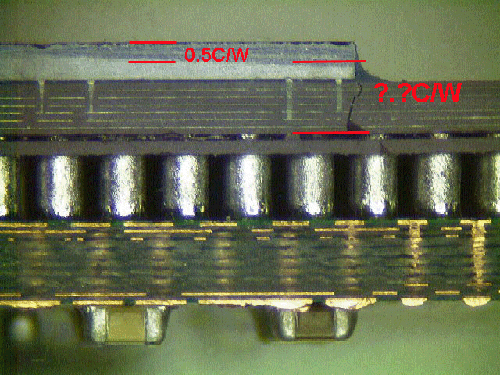|
|
|
I. Socket Thermistors Measure Temps at a Secondary Heat Pathway, Which Reflects Only A Portion of CPU Core Temp Change
The overriding factor in inaccurate socket-thermsitor and socket-a temp readings is that the readings are based on a secondary heat pathway. The problem with relying on a secondary heat pathway, and one that has unknown deviance/compression to the primary heat pathway and is not insulated, is that you get an unknown portion of CPU heat going into the particular secondary heat pathway you are measuring.
A very good diagram of this effect can be seen here
There are two real "valid" ways of measuring CPU core temp. Inside the actual CPU Core(such as p3 internal diode) or using a thermocouple installed in the heatsink at a known location for all heatsinks.
Any other way, be it side-thermistor or socket-thermistor, is by default a secondary heat pathway. While an insulated reading from either location can be made valid, one must know the thermal resistance from core to that location first.
And another problem would be that a socket-thermistor, in a best case scenario, touches the backside PCB with 1% of its surface area. The other 99% of its surface area are in contact with socket-air, so any slight air interference can disrupt this reading.
II. Compression of Thermistor Readings Explained
The other problem with socket-thermistor measurements is the massive temperature change compression that is seen. Theoretical core temp changes can sometimes be compressed by a factor of 3, or 4, or even up to 5 or 6. One question is, why is there compression. Well, we can take a look at a cpu-cutaway of a Slot Thunderbird(highlighted portions are the same as in a socket thunderbird)

The Core rests completely on top of a 7 Layer Ceramic PCB that is designed to not-absorb heat. CPUs are not designed to "radiate" heat in every possible pathway, but rather the primary pathway, which is CPU core to Heatsink.
AMD does not publish the thermal resistance(C/W) of core to core-back. Since this is unknown, and the percentage of heat that passes through the secondary heat pathway is different with each heatsink, it makes a socket-thermistor "reading" impossible to truly correct.
Examples of Socket-Thermsitor Reading Compression
in Major Website Publications